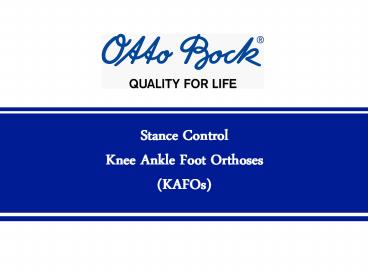Stance Control Knee Ankle Foot Orthoses (KAFOs) - PowerPoint PPT Presentation
1 / 12
Title:
Stance Control Knee Ankle Foot Orthoses (KAFOs)
Description:
... which provides stability but also causes patients to ambulate with a gait ... Body weight 300 lbs Cognitive inability to understand gait training ... – PowerPoint PPT presentation
Number of Views:628
Avg rating:3.0/5.0
Title: Stance Control Knee Ankle Foot Orthoses (KAFOs)
1
Stance Control Knee Ankle Foot Orthoses(KAFOs)
2
Stance Control Overview
- Stance Control Orthoses vs. Conventional KAFOs
- SCOs differ from Conventional KAFOs in that they
allow for knee flexion during the swing phase and
locking during stance phase.
3
Stance Control Overview
- Why Stance Control?
- A traditional KAFO can lock the knee in full
extension, which provides stability but also
causes patients to ambulate with a gait deviation
that can lead to overuse injuries due to
compensatory measures taken by the patient to
ambulate. This in turn requires more energy to
get from point A to point B. - A stance control orthosis (SCO) allows the knee
to bend during the swing phase of the gait cycle
and blocks knee flexion for stability during the
stance phase. By allowing the knee to bend during
swing phase, SCOs allow a more normal gait, which
may reduce secondary complications from gait
compensations, and allow the patient to walk with
less effort.
4
Stance Control Overview
- Benefits of SCOs over Conventional KAFOs
- Decreased gait anomalies during swing phase
- Vaulting
- Hip hiking
- Circumduction
- Decreased pulmonary/cardiac stress
- Esthetic gait pattern
5
Stance Control Overview
- Primary reasons that Stance Control Technology is
contraindicated - Moderate to severe spasticity of the hamstrings
- Permanent knee flexion gt 15 (contracture or bony
block) - Body weight gt 300 lbs
- Cognitive inability to understand gait training
- Inability to advance limb because of weak hip
flexors or lack of substitute - patterns to advance the limb in swing phase
- Lack of hip abductors in bilateral patients
6
SCO Study Reference Slides
7
KAFO Use
- KAFOs have historically had a rejection rate of
between 58 and 79, and over 40 of users state
that they are 'dissatisfied' with their orthosis.
1 - "Many users develop opinions on the device during
the first two weeks, and up to half of braces
will be rejected in this same period." (Fisher
and McLellan 1989 Butler et al. 1983).1 - "In the United States, approximately 989,000
people wear KAFOs (Russel et al. 1997).2 - 1. Consumer opinions of a stance control knee
orthosis, Katherine A. Bernhardt, et al.
Prosthetics and Orthotics International, December
2006 30 (3) 246-256 - 2. Gait Changes over time in stance control
orthosis users, Steve E. Irby, et al, Prosthetics
and Orthotics International, December 2007
31(4) 353-361.
8
Important Factors for Assistive Devices
- "A panel of six consumer experts with mobility
impairments ranked 15 different factors related
to assistive devices in general. The three most
important factors were effectiveness,
operability, and dependability." 1 - A survey conducted with 20 Dynamic Knee Brace
Systems (such as the Sensor Walk), had few
concerns about effectiveness, operability, and
dependability. - 1. Consumer opinions of a stance control knee
orthosis, Katherine A. Bernhardt, et al.
Prosthetics and Orthotics International, December
2006 30 (3) 246-256
9
Results of a study applying a Stance Control
Knee Orthosis (SCO) in place of a KAFO. 1
- On the braced limb The stance-control mode
- Showed a near-normal knee flexion wave in swing
- Reduced pelvic retraction and rotational
excursion - Improved hip power generation
- There was a trend towards improved energy
efficiency in stance-control mode - 1. Gait Evaluation of an Automatic Stance-Control
Knee Orthosis in a Patient with
Postpoliomyelitis, Jackie S. Herbert, et al. Arch
Phys Med Rehabil Vol 86, August 2005.
10
Results of a study applying a Stance Control
Knee Orthosis (SCO) in place of a KAFO.1
- On the non-braced limb the stance-control mode
- Allowed for the elimination of vaulting
- Reduced abnormal ankle and hip power generation
- Increased knee power absorption
- Provided for more typical quadriceps activation
- 1. Gait Evaluation of an Automatic Stance-Control
Knee Orthosis in a Patient with
Postpoliomyelitis, Jackie S. Herbert, et al. Arch
Phys Med Rehabil Vol 86, August 2005.
11
Results of a study applying a Stance Control
Knee Orthosis (SCO) in place of a KAFO.1
- The SCO/KAFO study concludes that use of a SCO
could return gait kinematics, power generation
and absorption patterns toward a more typical
pattern, while also offering greater energy
efficiency during ambulation. 2 - 1. Gait Evaluation of an Automatic Stance-Control
Knee Orthosis in a Patient with
Postpoliomyelitis, Jackie S. Herbert, et al. Arch
Phys Med Rehabil Vol 86, August 2005.
12
Efficiency of SCOs
- An efficiency study led by Kenton Kaufman, PhD,
from Mayo Clinic, showed that the difference in
oxygen consumption for a person using a locked
versus an unlocked knee was 1 ml/kg/mm. - For an able-bodied adult subject this difference
would roughly translate into a 10 difference in
walking speed. 1 - 1. Energy-Efficient Knee-Ankle Foot Orthosis A
Case Study, Kenton R. Kaufman, PhD, et al.
Journal of Prosthetics and Orthotics 8(3) 79-85,
1996.































